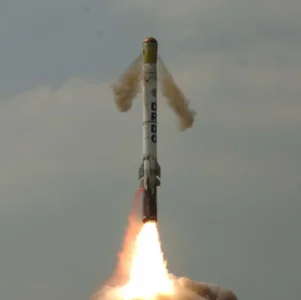View attachment 30862
An old graph of shauyra missile, for members who are not aware.
See the selected part written as hypersonic glide.
This trajectory reduces it's max range to just 700 from max range of "1800km using ballistic then depressed+Maneuver( evasive manurvers) in terminal phase".
In 700km max range mode its flies only depressed+manurable trajectory at an altitude of 40km at hypersonic speeds
Now, do you know what else flies at depressed trajectory with good manurability at an altitude of 30-50km with hypersonic speed?
The future Scramjet powered hypersonic cruise missile, which is all the rage as the latest/future missile tech.
So our shaurya missile in terms of speed, detection, difficultly to intercept is already in the league to HCM when it flies in 700km max range trajectory.
( now you may wonder why are we then developing scram jet, the answer is efficiency, an airbreathing scramjet will be lot more efficient than rocket motor, so lot more range in same size/weight missile or similar range with smaller missile).
But HCM are hyped due to their
1, depressed trajectory that makes them harder to detect.
2, ablility to manurable and not have predictable path( unlike ballistic and quasi ballistic missiles)
3, and do both of these at "hypersonic speed"( subsonic and supersonic missiles can do both 1 and 2 both but limited by speed, also supersonic and subsonic missile can fly at even more depressed trajectory, and can even do sea skimming).
And shaurya in depressed mode can do all three of these.
In depressed trajectory shaurya Is basically a land attack hypersonic cruise missile( cruise part is a flight characteristics not a method of propulsion) with max range of 700km, and we had this missile for more than a decade.
Also, from wikipedia.
"On 3 October 2020, DRDO successfully test-fired an advanced version of the Shaurya with an 800km range from Balasore as part of user trials."
Max range of just 800km means they are talking about depressed trajectory.
This also questions, the definition of hypersonic cruise missiles, for general public it became synonyms with scramjet engine.
But again scram jet is just a method of propulsion to reach hypersonic speed and cruise at that speed, you can do the same with rocket motor( tho as said before efficiency is lot worse).
So currently we can create subcategories of hypersonic cruise missiles.
HCM-RP( rocket powered) And HCM-AB( air breathing aka, scramjet in this case).
So again, we already possessed A land attack HCM with max range of 700-800km for more than a decade.
Also russian hypersonic zircon, from the pics released and leaked doesn't seem to have any air intake, and I'm 90% sure it's rocket powered.
Plus it's dimensions are similar to shaurya and max range is Said to be 1000km, which further bolster my suspension of it being rocket powered HCM( a scramjet powered missile of that size should have lot more range)
Though unlike shaurya which is land attack, zircon is antiship( thrust vectoring, seeker, smaller warhead) tho can be used for land attack.
( now 1000km range seems good for ships based anti ship missiles but if Russians used scramjet they could have made a smaller missile with similar range as zircon, so more missiles could be fitted on the ship)
IN terms of dimensions both shaurya and zircon are slighly longer and slightly thicker than brahmos( tho both should be lot heavier because brahmos has airbreathing ramjet engine, while shaurya and zircon both need to carry all the fuel inside)
And if we want to we can develop a anti ship HCM-RP similar to zircon using shaurya as a base.
LR-ASHM from land to ship
Shurya based HCM from ship to ship.
Along with working on its own scramjet China seems to be going the route of making anti ship varient of its df17 HGV( anti ship varient tested already, tho in service ones are land attack only, for now)
And doublking down on its df21 ballistic anti ship hypersonic missile.( very hard to intercept also but very hard to make it accurate enough to hit ships, plus needs to fire lots of missiles just for good probability of hit due to lack of accuracy, plus need to be supported by dedicated kill chains comprised of satellites, ground and aerial radars and all these are very expensive and also vunrable to enemy attacks both cyber and physical )
Our recently tested LR-ASHM is also a HCM-RP, thought drdo calls it "glide vehicle".
Drdo also called the trajectory of shaurya as hypersonic "glide".
But the trajectories of both these missiles seems identical to trajectories of HCM rather than trajectories of HGV's.
Plus both do not generate enough lift to be called a HGV like Russians Avangard or chinese dfzf HGV.
The only benifit of scramjet in HCM over rocket motor is it being "lot more efficienct".
But there are lots of difficulties to overcome to get the benifit of efficiency.
1, scramjet itself difficult to develop while rocket motors are already present and decades of experience with these motors.
2, even if scramjet is developed designing a missile around it is also lot more difficult, with rocket motors you can just put them in back and have rest of frontal space available for fuel and sensors a design that had been used for decades.
lastly in 2020 north korea also seemed to tested a two stage" land attack rocket powered missile" and description of the trajectory makes it look similar to similar to HCM-RP, so once you take away the "scramjet" aspect of HCM, they become lot more easier to develop, the only downside being significant reduction in efficiency.
But that missile is land based( size is not that big of a problem) and korean peninsula is small so range will be more than sufficient,Like our land based anti ship LR-ASHM gives already 1500+km max range( NK one is land attack varient)
And shaurya in "hypersonic glide" mode already gives 700-800km range.
With zircon having ~1000km.
So if size and range are sufficient for you/ meets the requirements, then HCM-RP is better choice than HCM-AB
And if you wanna know, why HCM are so much hyped.
This is a good video
View: https://youtu.be/AT7y94mb-eA?si=JFKN06VuDkEWquo_
So we are actually the *1ST* country to biuld a HCM( in terms of difficulty to intercept, As HCM are hyped due to how much harder it is to intercept them, right now nobody in the world has air defense who have good/decent chances to intercept HCM, tho US has made the most progress in developing that type of air defense).
As for scramjet engine, US is leading in that, with India being not far behind.


 , offer similar accuracy. But their air-breathing engines carry them along slowly, rendering them vulnerable to enemy aircraft and missiles. The Shaurya’s solid-fuel, air-independent engine propels it along at hypersonic speeds, leaving enemy fighters and missiles far behind.
, offer similar accuracy. But their air-breathing engines carry them along slowly, rendering them vulnerable to enemy aircraft and missiles. The Shaurya’s solid-fuel, air-independent engine propels it along at hypersonic speeds, leaving enemy fighters and missiles far behind.












 Our missile tech really sucks when our 5ton missile has same range as 3.7 ton russian missile of the "same" category.
Our missile tech really sucks when our 5ton missile has same range as 3.7 ton russian missile of the "same" category.


